Your Account-Based Marketing Playbook: 4 Events To Drive Pipeline and Revenue
Maximize Your Marketing ROI
Join 10,000 other marketers already getting the best tips on running engaging events that boost pipeline and create raving fans.
At this point, it's table stakes for your B2B company to plan and host events. At the same time, you may also be using some form of account-based marketing (ABM) to personalize your marketing efforts and make sure each campaign lands with its intended audience.
For years, marketers have touted the benefits of ABM, with almost all of marketers surveyed saying it has a higher ROI than other tactics.
So, what if you married the two? Picture this: Events + ABM = a winning equation!
Could it be that simple? Well, we think so! We've seen firsthand that ABM strategies are the perfect complement to digital events. With a careful approach, you too can transform the purpose and passion behind each event and really boost pipeline and revenue down the road.
Today, we'll dive into:
- Engaging your most valued accounts with ABM: a webinar
- What is account-based marketing?
- How to segment your lists and target for ICPs
- Account-based marketing goals
- Other ABM event metrics to watch
- 4 types of events to engage your target accounts
- How to follow up after an ABM event
- A Goldcase case study: Do ABM events actually work?
- Now you know the ABCs of ABM events!
Let's get started!
Engaging your most valued accounts with ABM: a webinar
For our recent Rock Your Funnel series, our Head of Events and Community Outreach, Belinda Joseph, talked with:
- Leslie Blanchard, Director of Field Marketing at GitLab
- Karah Blandford, Field Marketing Manager at Chili Piper
- Michelle Radlowski, Senior Director, AMS and EMEA Regional Marketing at DigiCert
Together, this panel covered a lot of ground about account-based marketing and how to nurture your leads!
Check out the full session below for a comprehensive look at how to reach your most important accounts. ⤵️
✨ Psst: You can unlock all of our Rock Your Funnel content on-demand now!
What is account-based marketing?
Whether you call it that or not, account-based marketing—or ABM—is something you're probably already doing.
For example, if you're segmenting your email lists and personalizing the content that goes out to each one to promote an event or resource, that's ABM. Or, if you've ever planned an event specifically for a group of decision-makers, that's ABM, too.
ABM is exactly what your event strategy needs. When you first start out with events, it's easy to focus solely on driving registration and awareness as high as possible. The more, the merrier! However, that doesn't actually lead to a healthy pipeline and revenue stream for your company.
You know what does? Attracting and inviting people in your target audience to your events! Those people are much more likely to be open to the information you're providing and use it to make their purchasing decisions down the road.
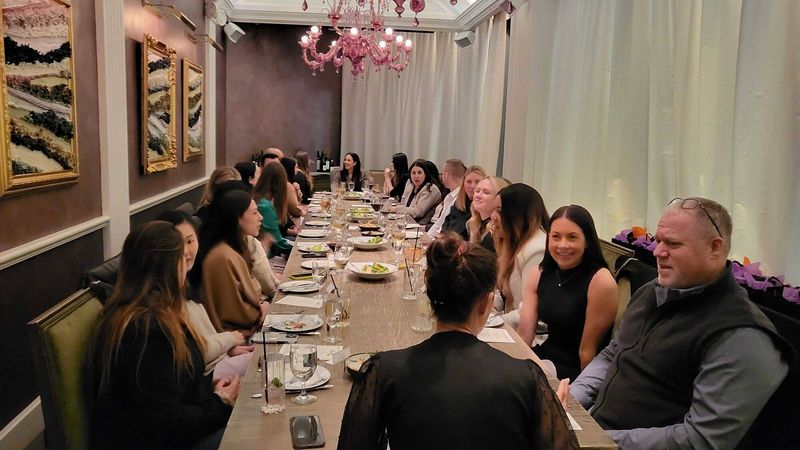
Goldcast enjoyed hosting industry-leading B2B marketers for great conversations over dinner in Boston, MA in March, 2023.
How to segment your lists and target for ICPs
To begin, our experts recommend thinking about your target list. Look at industries, regions, and personas. Where do most of your ICPs reside? If you're hosting an in-person event, or even doing a hybrid format, where people live will be super important.
Who you target will also depend on what type of event you're hosting. For example, an intimate dinner-style event would be better suited for the C-suite, while more informal happy hours could work for directors, managers, and other roles.
Once you decide who you want to invite, personalization is the name of the game. You can go about this in different ways.
Karah shared that the Chili Piper team has found success using alias emails for top sales and marketing leaders. So maybe you send an email from your SVP to top sales leaders you want at the event; this feels super personal to the person receiving it, which makes them more likely to explore attending.
Michelle talked about intent data, which helps DigiCert assign leads an engagement score (psst: we do this too!) that determines what sort of messaging each person receives. Basically, if someone is regularly engaging with current content, you want to approach them in a different way than someone who's pretty new to your brand.
One note here: In today's remote-first world, you may have to take extra steps to identify where people actually live. You'll have to experiment to find a way that works for you, whether it's using LinkedIn searches or adding extra fields to your event registration forms to collect that data.
Because of the distributed workforce, virtual events should always be part of the event strategy." - Michelle Radlowski
Account-based marketing goals: Quality > quantity
As we touched on earlier, ABM goals are not centered around making sure the most people come to your event. It's hard to quantify pipeline because, as one attendee pointed out, event leads have a much longer life cycle than your typical sales cycle.
This is why the panel looks at influenced pipeline vs direct pipeline.
At GitLab, they've set up a custom influence model that allows them to analyze the overall impact of every touchpoint along the customer journey. "We know it doesn't just take one touchpoint to create or close an opportunity," remarks Leslie. You may be able to track this data by using campaign fields or looking at engagement models in your CRM system to see a customer's engagement history.
"We know it doesn't just take one touchpoint to create or close an opportunity." Leslie Blanchard
Michelle calls this constellation of touchpoints the "anatomy of a deal," a nod to the fact that a successful close involves a lot of different factors. She pointed out that you may need to educate your internal stakeholders that it does take multiple touches to convert a customer—it rarely happens on the first engagement.
Another metric you could keep an eye on is how many sales meetings were set up post-event. This could give you a good idea of interest level and how many folks are on their way to purchasing!
In the meantime: Other ABM event metrics to watch
We know that the full-funnel journey will take some time to play out. While you're waiting, monitor these metrics so you can keep your finger on the pulse of how your events are doing.
Here are a couple of metrics that might make sense for your company:
- Registrations: This is more than just looking at the total number who signed up. Are you reaching the right contacts at the right accounts? How many of the people you intended to reach through your ABM efforts signed up?
- Show Rate: Though we wish it were the case, the show rate is never quite equal to registrations! How many people are actually attending your events? (Note: A low show rate may indicate you'd benefit from some reminder emails or other tools to make attending easy, like magic links!)
And for digital events, you could also add these to your reporting:
- Engagement Rate: How active and attentive are attendees during the experience? Are there areas of the event when engagement slows down? If so, is there anything you can do to address that for future events?
- Resource Clicks: This looks at how many people click on the resources you share during the event. Resource clicks can give you insight into what was especially helpful to share during an event or shine a light on things people aren't finding as valuable.
- CTA Clicks: Take a peek at how your Calls to Action are doing. Are people doing what you wanted? Are certain CTAs working better than others?
All of this info can give you plenty to work on while you wait for that pipeline to grow!
One last note: For digital-first events, be sure your event platform can seamlessly sync data across your entire tech stack. This makes it a cinch to unlock powerful insights for your sales team so they can follow up with people in meaningful, purposeful ways.
📈 Want to go deeper? Check out this guide to virtual event KPIs!
4 types of events to engage your target accounts
Now it's time to get into the really fun part: planning your future events! The type of event that makes sense for your audience depends on where they are in the sales funnel. You want to get more granular as a person goes through the customer journey, so think about events that might work for top of funnel contacts vs bottom of funnel.
We've found that, in general, these four types of events work particularly well for engaging your target accounts. There's something here for everyone, from webinars to super-specific field events. Let’s break it down.
1. Thought leadership series
Thought leadership events, which are used to position your brand as an expert in your industry, usually happen online but can also be held in person. However, doing a virtual thought leadership series has the benefit of opening up your potential speaker (and attendee) pool far beyond your geographic region.
A solid example? Our very own Event Marketers Live series! Each session features marketing industry leaders talking about how they brought their own events to life. We do this series mostly online, with an occasional hybrid event thrown in the mix.
Thought leadership events can be a good first step to get a target account into your ecosystem and introduce your brand. Maybe they're more likely to attend because you've got a name they recognize on the speaker roster, and they're curious about what that person has to say. Or it's possible they're interested in the specific topic your speaker will be presenting on and want to know how it applies to their work.
These series can also work to move people down the funnel. If someone's familiar with your brand and still deciding, thought leadership sessions help establish you more in their minds as an expert who can be trusted.
2. Webinars
Ahh, webinars—the tried-and-true event format! These are online, single-session events that typically clock in around an hour or less.
Webinars can be used for a variety of goals, though most are used for demand-generation purposes. From an ABM-focused lens, webinars are great tools for nurturing your leads. To do this, you'll need to feature a highly relevant topic that provides value to your audience.
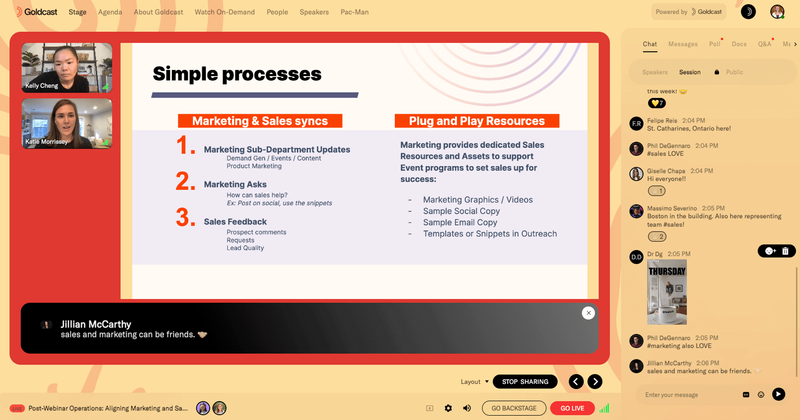
Ideally, you want people to feel like the event was designed just for them—after all, that's the point of ABM! Try to work in ways that attendees will feel welcomed and included during your event, whether it's bringing certain attendees on stage to ask questions or offering them meaningful ways to interact with other attendees they can learn from.
After the event, be sure to hone in on those metrics we talked about earlier. If people were super engaged during your event, those should be the first folks your sales team follows up with! You can also use that info to craft hyper-personalized post-event follow-up messaging to further guide prospects along their journey.
3. Conference or summits
Though ABM brings to mind super personalized, small-group marketing methods, don't completely write off large-scale events like conferences or summits.
These events could be in-person or digital—or both (hello again, hybrid events!). The benefit of a big event like this is you can appeal to a wide group of people who are attending for different reasons.
For example, an existing customer may sign up for your event with the goal of meeting other loyal customers. In this case, your conference can help retain that customer and reduce churn. Maybe that person also learns something new and ends up referring other people to you.
Awesome, right?
On the other hand, a new-to-you prospect might attend because they want to learn more about you, whether from speakers or other attendees. The conference is a great chance to showcase your company value, as well as the sense of community your brand brings with it!
You can see you'll have to think through ways to deliver personalized messaging, as well as a thoughtful experience, for the different potential segments within the larger conference crowd. This is why large-scale events take more work, ABM-wise, than a smaller, more intimate event. But again, that doesn't mean it's not worth doing!
Remember not to get too hung up on the number of people that attend. As we talked about earlier, your main focus should always be on the quality of the people who come. Ten of your ideal customers showing up is far more meaningful than one hundred random people who don't match your buyer personas!
4. VIP or Field Events
VIP or field events are often held in person but can be digital, depending on your situation. Designed to accelerate and close deals, VIP events segment out the decision-makers or executives at an organization and provide a meaningful, impactful experience.
ABM really shines with these highly curated events! We saw this with our ABM webinar audience as well, with over 28% of people polled saying they're hosting dinners and networking events for their audience.
The focus here is on connection and building trust within these important relationships. There are myriad ways to host field events. If you're meeting in person, you could do a more traditional VIP dinner, rent out a private suite at a sporting event for your guests, or do a fancy happy hour at an unexpected location.
If you're choosing to meet virtually, you might host a cocktail-making class and send the ingredients to attendees beforehand, provide entertainment by way of a magician or mentalist, or even do a crafting or yoga class with attendees!
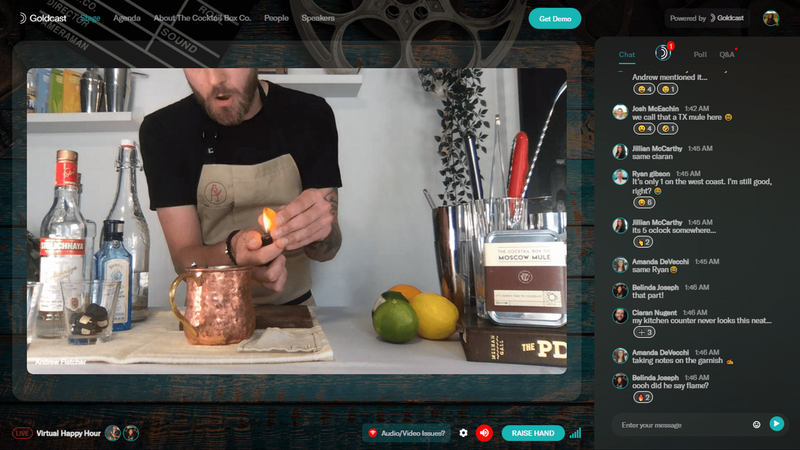
How to follow up after an ABM event
You already know the work doesn't end when the event is over. Now it's time to follow up!
Here are some follow-up ideas:
- Book meetings in real time with prospects who show intent and want to learn more about your product
- Segment your list into people who attended vs didn't attend and send them customized messaging
- Spark FOMO in people who didn't attend by sharing photos and video snippets, with the hopes that this gets them more interested in your content or future events
- Give your sales team context about what attendees were talking about and what problems they're trying to solve. Empower them to follow up and personalize their messaging to close the loop!
- Host a meeting for leadership, sales, and staff who were at the webinar. Together, go through people who attended, identify hot leads, and share notes on how to move forward.
- Send out a post-event survey to ask for feedback!
The most important thing here is to be clear. Who owns what? When should follow-up be done? What's working? What's not?
And don't forget to turn your events into other valuable content! Think about ways to recycle or repurpose content and feature it across platforms. Focus on creating relationships over time—as Karah put it, "People buy from other people." Your audience wants to build relationships, and that can sometimes matter even more than the value prop you bring to the table.
A Goldcast case study: Do ABM events actually work?
All of this may sound good in theory, but you may be wondering if it will actually work for your company.
Well, we've been there, and we can confidently say, "Yes!"
ABM events absolutely worked for us. To illustrate this, let's talk about our VIP dinner series!
The idea behind Goldcast's VIP dinner series
At Goldcast, we hosted a VIP dinner series for our key customer and prospect accounts across various cities. We worked as an organization to identify who to invite, with the goal of increasing renewals, expanding accounts, and lowering churn risk.
Ultimately, we decided we wanted a room of 15-20 customers or prospects. Together, we'd discuss the current challenges that event marketers face, talk about their 2023 strategies, and then figure out how Goldcast could help.
Before the event
Prior to the event, registrants filled out a survey in which they shared their challenges, priorities, and some thoughts about virtual event experiences. That helped us direct conversations throughout the evening. It also provided us with some additional insights into what customers are thinking about, which we used for future messaging.
We also made sure to develop seating charts! We strategically placed prospects next to customers so that they could talk about their experience with Goldcast and boost our word-of-mouth efforts!
Event structure and promotion
The agenda for the three-hour event looked like this:
- Cocktail reception (30 minutes)
- Brief comments from our CRO
- Dinner, with informal discussions taking place throughout
To promote the event, we sent out targeted emails to our list. We also made sure guests received personal invites from their account owners and members of the executive team.
Belinda Joseph, our Head of Events and Community, personally reached out to each registrant to introduce herself as the point of contact. She also made sure to provide the survey we wanted them to fill out before the event, a list of all attendees (so people knew what to expect), Uber vouchers to take care of transport to/from the restaurant, and final logistics instructions.
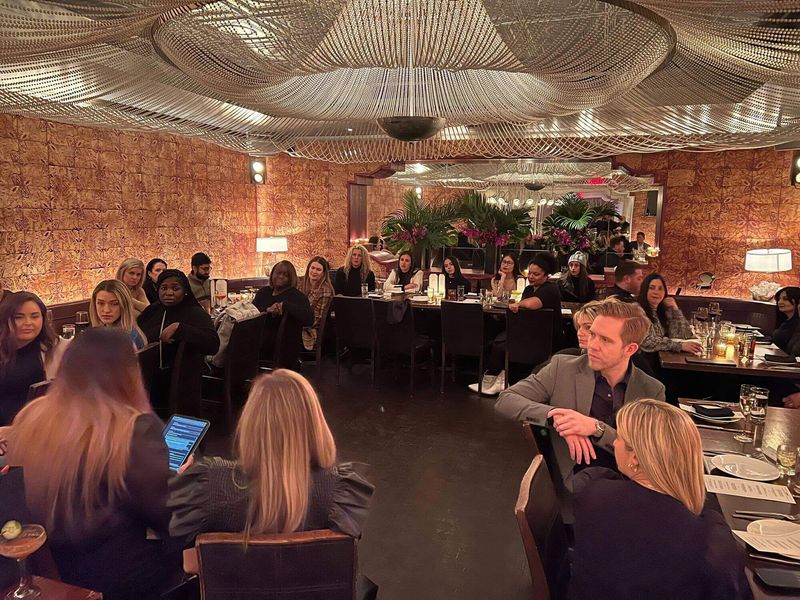
When you're doing a white-glove event like this, you want to be sure to think of all the details! Leave no stone unturned in your planning process. Your attendees will definitely notice that level of attention to detail.
What were our results?
After the event, our CRO reached out to every attendee to thank them for attending and offer additional assistance or follow-up conversations.
The dinners were well received and saw up to 80% attendance rates. Feedback across the board was extremely positive; people told us that an event like this allowed them to meet and connect with their peers, share stories, and get inspired about their work.
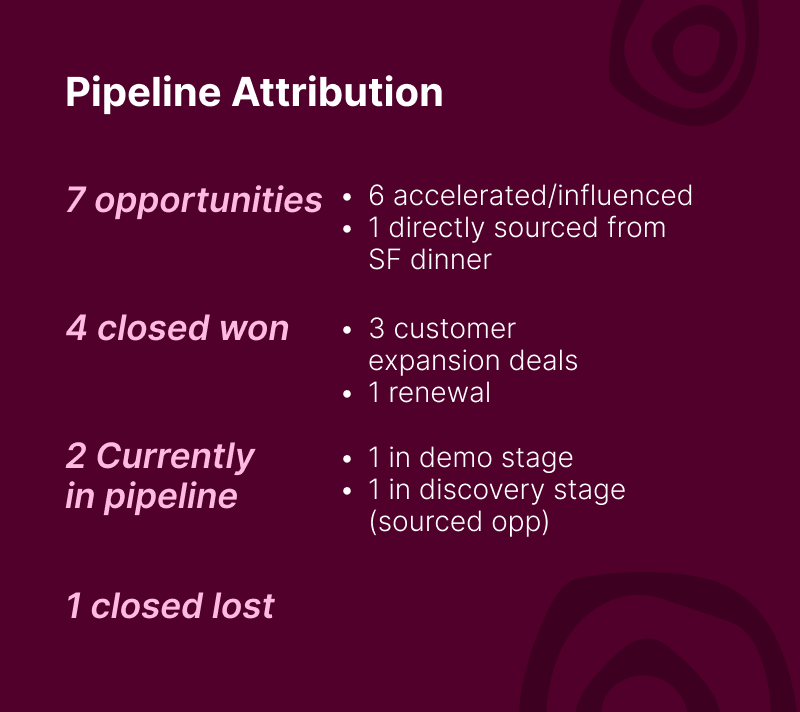
On our side, the event provided a valuable opportunity to get in front of new accounts who were not familiar with Goldcast and let them know what we're all about. Additionally, our executive team, sales reps, and product team all got face-to-face time with clients to get real-time feedback on the Goldcast platform and how we can improve it.
Our plans for future VIP dinners
Because of the success of that initial series, we're continuing the VIP dinners in 2023. We've learned our ideal customer is hungry for knowledge and connection—and we've figured out a way to provide both!
In order to deliver more value and education for attendees, we'll be adding in an industry expert guest speaker, as well as creating a theme for each event. We've already seen huge boosts in our registration numbers and can't wait to continue convening with our customer base in this way.
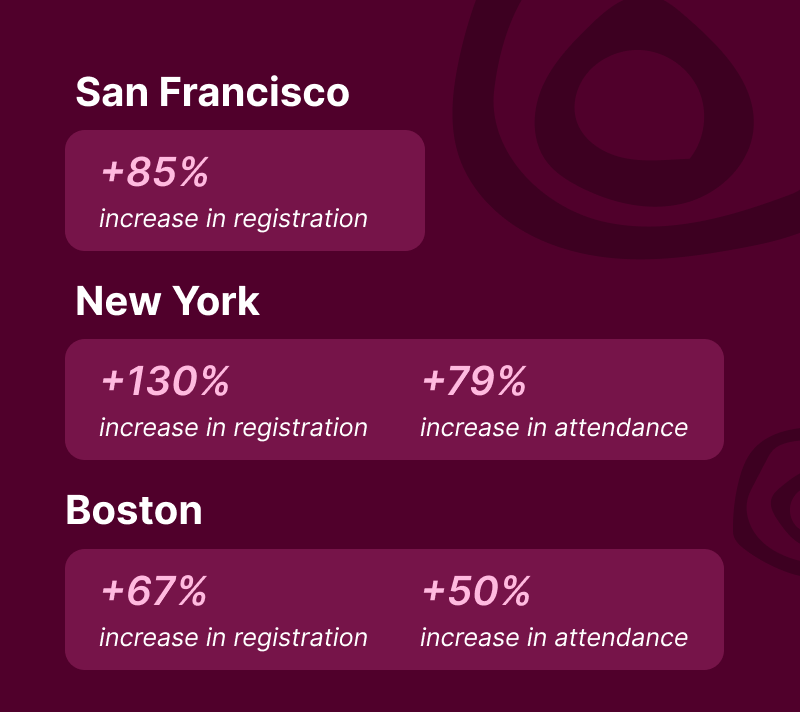
Now you know the ABCs of ABM events!
We hope we've inspired you to apply an account-based marketing approach to your future events. You don't have to start with a white-glove VIP dinner series, either—try experimenting with some tips from this guide for your next webinar!
Finally, remember that pipeline and revenue will take a while to grow, but there's no time to start like the present. Good luck!

Transform Your Video Marketing with AI
Stay In Touch
Platform
Resources
© 2025 Copyright Goldcast, Inc. All rights reserved.





 Upcoming Events
Upcoming Events Event Series
Event Series On-Demand Events
On-Demand Events

